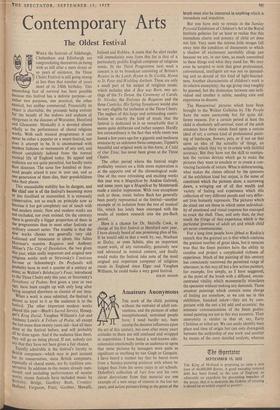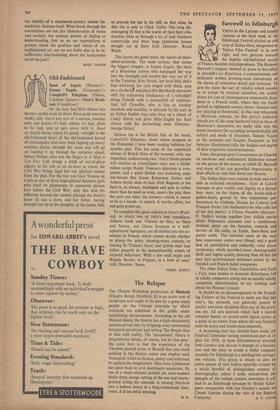Amateurs Anonymous
THE work of the child, painting without the restraint of adult con- ventions, and the pictures of other unsophisticated, untrained people have, I need hardly say, been among the decisive influences upon the art of this century, but even after many years attitudes to them are still confused and wrapped in superstition. I have heard a well-known edu- cationalist emotionally invite an audience to agree that some pictures by teenagers were quite as significant as anything by van Gogh or Gauguin. I have heard a student say that he learnt more from a Sunday-painting postman with whom he lodged than from his seven years in art schools. Dubuffet's collection of l'art brut and his own clever derivations from that material are one example of a new surge of interest in the last ten years, and action painters living at the point of the brush must also be interested in anything which is immediate and impulsive.
But you have only to remain in the Sunday Pictorial Exhibition of Children's Art at the Royal Institute galleries for an hour to realise that this immediate charm and potency of child art does not last. Very soon the intense little images fall away into the condition of documents to which a shadow of excitement inevitably clings just because we are, in our time, so much committed to these things and what they stand for. We may even be tempted to wish that great professional, conventional, intelligent art was not so demand- ing and so devoid of this kind of light-hearted- ness. Another characteristic of children's work is its relative anonymity; the age group may roughly be guessed, but the distinction between one indi- vidual and another is subtle, needing care and experience to discern.
The Housewives' pictures which have been brought to the Walker Galleries by The People have the same anonymity but for quite dif- ferent reasons. For a certain period at least the child is absolutely self-centred; most of the adult amateurs have their minds fixed upon a certain ideal of art, a certain kind of professional paint- ing of 'landscape, flowers, pets, or if not on that upon an idea of the actuality of things, an actuality which they try to re-create with faithful accuracy. But they have not the skill to manipu- late the various devices which go to make the pictures they want to emulate or to create a con- vincing facsimile of nature. What is disheartening, what makes the claims offered by the sponsors of the exhibition kind but unjust, is the sense of constraint which the pictures show, a narrowing down, a wringing out of all that wealth and variety of feeling and experience which this collection of very different people and very differ- ent lives humanly represents. The pictures which do stand out are those in which some individual- ity of emotional and visual response has managed to crack the shell. Then, and only then, do they touch the fringe of that experience which is the particular 'province of adult art and which child art never communicates.
For a long time people have jibbed at Ruskin's remark that the greatest art is that which contains the greatest number of great ideas, but it remains true that the finest painters have the ability to canalise and project a complicated richness of experience. Much of the painting of this century has consciously narrowed the permitted range of utterance; in this way all but a few action painters, for example, live simply, as I have suggested, at the point of the brush with a diffused, uncon- centrated vitality which momentarily stimulates the spectator without making any demands. Those amateur paintings which contain some charge of feeling are somehow, as we can see in this exhibition, knocked askew—they are by com- parison with the rest a bit odd and eccentric; the intensest communications of the finest profes- sional painting are not in this way eccentric. Their anonymity is similar to that of, say, Early Christian or tribal art. We can easily identify their place and time of origin but can only distinguish between the authorship of one work and another by means of the most detailed analysis, whereas
the identity of a nineteenth-century master im- mediately declares itself. What break through the conventions are not just idiosyncrasies of vision and method, but unusual powers of feeling or understanding. Just as we are superstitious at present about the qualities and values of un- sophisticated art, are we not liable also to be in- sufficiently discriminating about the anonymous art of the past?
BASIL TAYLOR



































 Previous page
Previous page